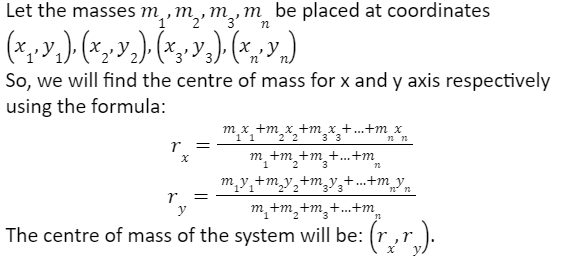Centre of mass formulaThe formula for centre of mass are as stated below |
||
| Description | Formula | |
| Centre of mass of a system with n number of masses situated on a line at different positions | |
|
| Centre of mass of a system with n number of masses situated on a 2D plane |  |
|
| Centre of mass of a rectangular plate | The centre of mass of a uniform rectangular plate of length L and breadth B is given as: r_x=B/2 r_y=L/2 | |
| Centre of mass of a triangular plate | The centre of mass of a uniform triangular plate is given by the formula: r_c=h/3 Where, h is the height of the plate. | |
| Centre of mass of a semi-circular ring | The centre of mass of a semi-circular ring is given as: r_y=2R/π r_x=O Here, R is the radius of the semi- Circle. | |
| Centre of mass of a semi-circular disc | The centre of mass of a semi-circular disc is given as: r_y=4R/3π r_x=O Here, R is the radius of the semi- Circle. | |
| Centre of mass of a hemispherical shell | The centre of mass of a hemispherical shell is given as: r_y=R/2 r_x=O Here, R is the radius of the semi- Circle. | |
| Centre of mass of a solid hemisphere | The centre of mass of a solid hemisphere is given as: r_y=3R/8 r_x=O Here, R is the radius of the hemisphere. | |
| Centre of mass of a circular cone | The centre of mass of a circular cone is given as: r_y=h/4 Here, h is the height of the cone. | |
| Centre of mass of a hollow circular cone | The centre of mass of a hollow circular cone is given as: r_y=h/3 Here, h is the height of the cone. | |
Circular motionThe formula for circular motion are as stated below |
||
| Description | Formula | |
| Average angular velocity | ω_average=(θ_2-θ_1)/(t_2-t_1 )
|
|
| Average angular acceleration |  |
|
| Tangential acceleration | a_t=dV/dt Here dV is the change in velocity over time dt. a_t=r dω/dt Here, r is the radius, dω is the change in angular frequency over time dt. | |
| Centripetal acceleration | a_c=v^2/r or a_c=ω^2 r Here, v is the linear velocity, r is the radius and ω is the angular frequency. | |
| Normal reaction on a body moving on a concave bridge | N=mg□cos cos θ +(mv^2)/r Here, m is the mass, g is the gravitational acceleration, θ is the angle, v is the linear velocity and r is the radius of the bridge. | |
| Normal reaction on a convex bridge | N=mg□cos cos θ -(mv^2)/r Here, m is the mass, g is the gravitational acceleration, θ is the angle, v is the linear velocity and r is the radius. | |
| Safe velocity of a vehicle on a level road | v_safe≤√μgr Here, v safe is the safe velocity, is the coefficient of friction, g is the gravitational acceleration and r is the radius. | |
| Banking angle | tan θ =v^2/rg Here, θ is the banking angle, v is the linear velocity, r is the radius of the curve and g is the gravitational acceleration. | |
| Centrifugal force | f=mω^2 r Here, f is the centrifugal force, m is the mass, is the angular velocity and r is the radius. | |
| Conical pendulum | T=2π√((L cos θ )/g) Here, L is the length of the pendulum, θ is the angle made by the string with the vertical and g is the gravitational acceleration. | |
De Broglie wavelength formulaThe formula for de broglie wavelength are as stated below |
||
| Description | Formula | |
| De Broglie wavelength |  |
|
| Radius of electron in hydrogen like atoms | r_n=n^2/Z a_0 Here, rn is the radius of nth orbit, a0 is a constant whose value is0.529×10^(-10) m m and z is the atomic number. | |
| Speed of electron in hydrogen like atoms | v_n=Z/n v_0 Here, Z is the atomic number, n is the orbit and v0 is a constant whose value is 2.19×106m/s. | |
| Energy in nth orbit | E_n=E_1⋅Z^2/n^2 Here, En is energy of the nth orbit, E1 is the energy of the 1st orbit and its value is -13.6 eV, Z is the atomic number and n is the number orbit | |
| Wavelength corresponding to spectral lines | 1/λ=R[1/(n_1^2 )-1/(n_2^2 )]
 |
|
| Minimum wavelength for x rays | λ_min=hc/(eV_0 ) Or λ_min=12400/V_0 ×10^(-10) m here, min is the minimum wavelength, h is the plank’s constant, c is the speed of light, e is the charge of an electron and V0 is the accelerating voltage. | |
| Radius of nucleus | R=R_0 A^(1/3) Here, R is the radius of the atom, R_0 is a constant whose value is 1.1×10^(-15)m, A is the mass number of the atom. | |
| Number of nuclei during a radioactive decay | N=N_0 e^(-λt)here, N is the number of nuclei at time t, N_0 is the initial number of nucleus and λ is the decay constant. | |
| Half-life of a radioactive sample | T_(1/2)=0.693/λ Here, T1/2 is the half-life period and λ is the decay constant. | |
| Average life | T_av=T_(1/2)/0.693here, T_avis the average life and T1/2 is the half- life period. | |
JEE Physics Important Formulas Part 2
In this article we will go through physics quick formula revision for JEE 2022. Find the important formulas of Centre of mass, Circular motion and De Broglie wavelength.
 Profile
Profile Settings
Settings Refer your friends
Refer your friends Sign out
Sign out



